Abstract
The nucleotide sequence of the P gene of human parainfluenza virus type 1 (PIV1) was determined from cloned cDNA copies of the mRNA. By analogy with the gene organization of Sendai virus, two open reading frames in the mRNA sense of the gene were identified as coding sequences for the P protein (568 amino acids with an estimated molecular weight of 64,655) and the C protein (204 amino acids with an estimated molecular weight of 24,108). Comparison of the deduced amino acid sequences of the P and C proteins of PIV1 with those of Sendai virus showed a high degree of homology. However, a sequence for the cysteine-rich V protein, which was considered a common feature of other paramyxoviruses, was interrupted by the presence of multiple stop codons. The sequence analysis of three P-gene-specific cDNA clones generated from genomic RNA by polymerase chain reaction and one additional clone generated from mRNA confirmed that the coding sequence for the cysteine-rich region is silent in the PIV1 gene and thus is not translated into protein. Two potential editing sites with the consensus sequence 3'UUYUCCC were found in the PIV1 P gene at positions 564 to 570 and 1430 to 1436. However, examination of the PIV1 mRNA population by a primer extension method indicated that neither of these sites is utilized. These results indicate that the PIV1 P gene has a coding strategy different from those of other paramyxovirus P genes.
Full text
PDF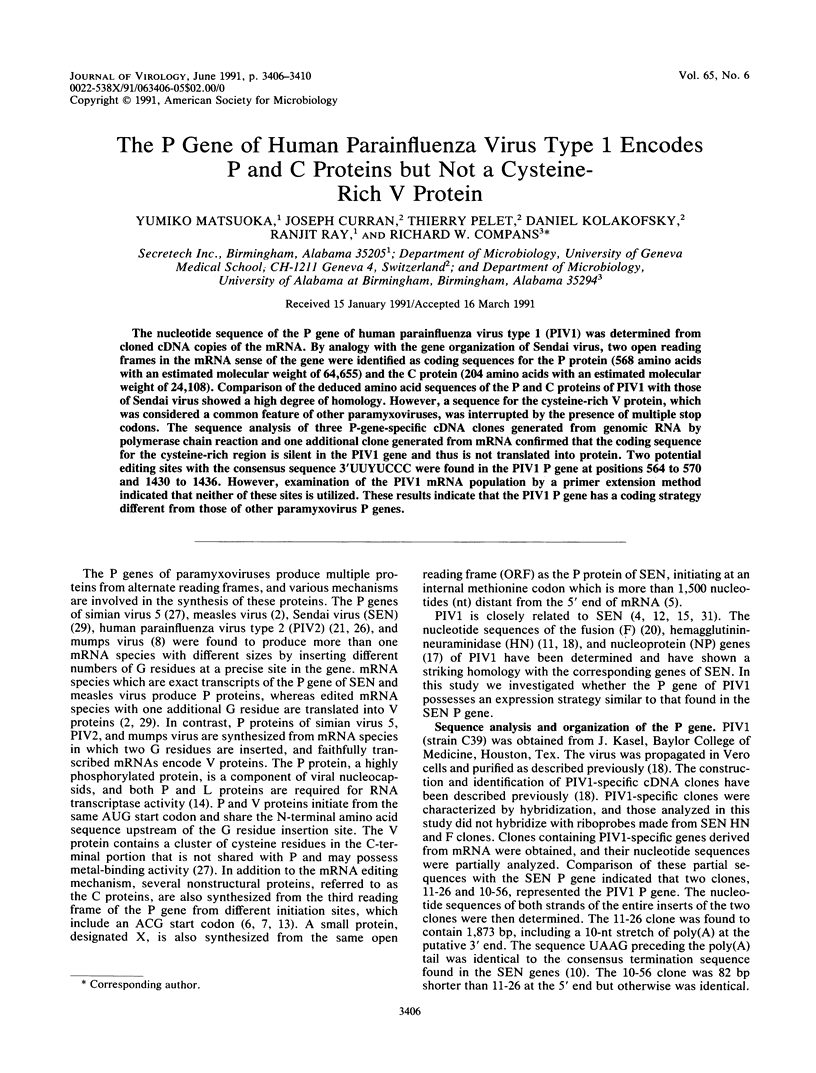
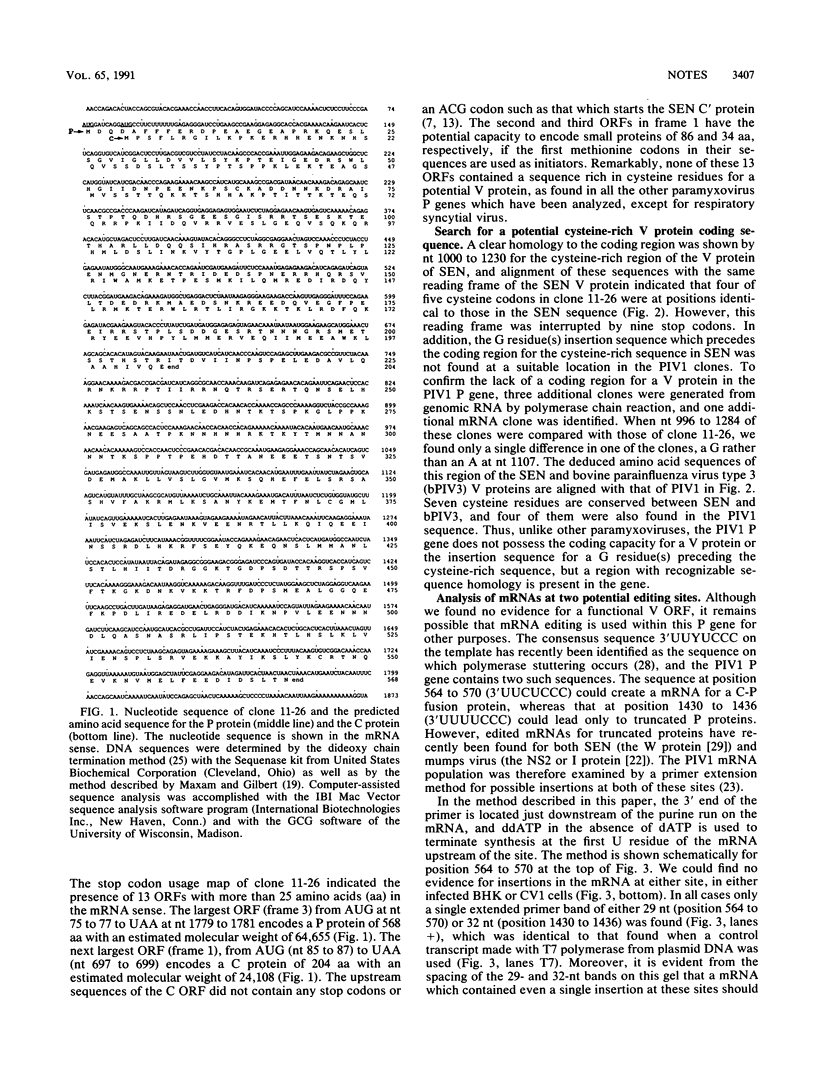
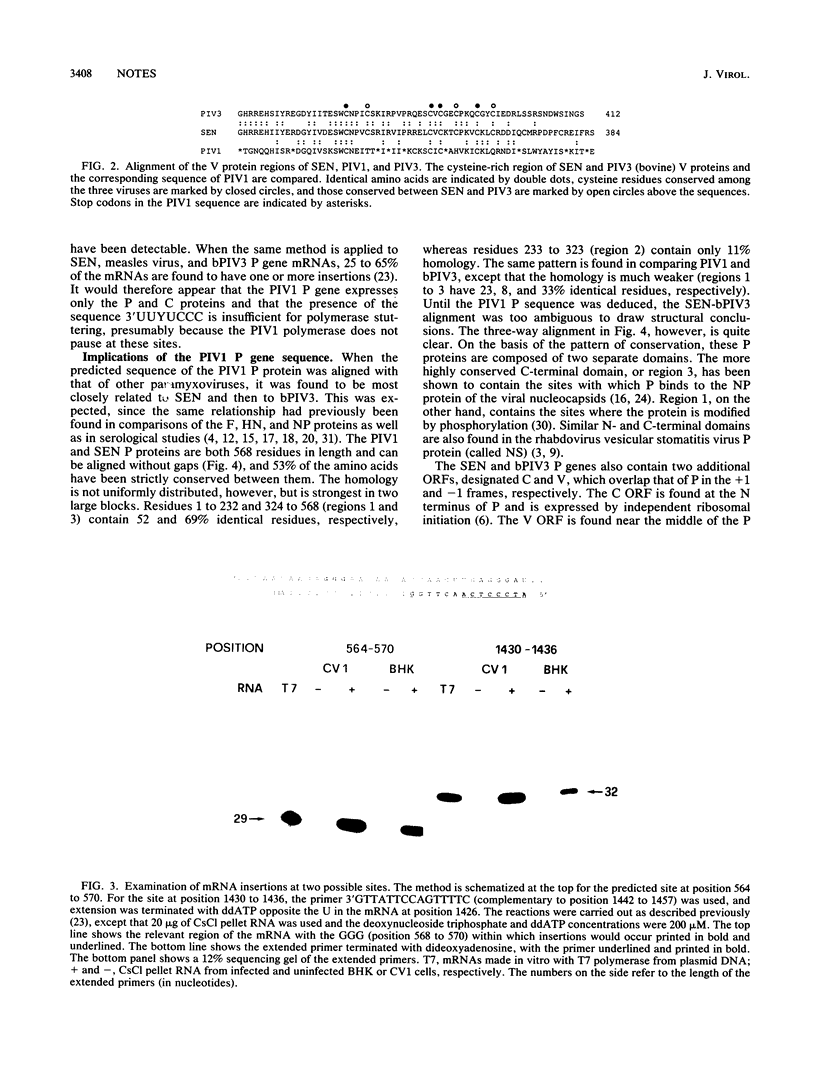
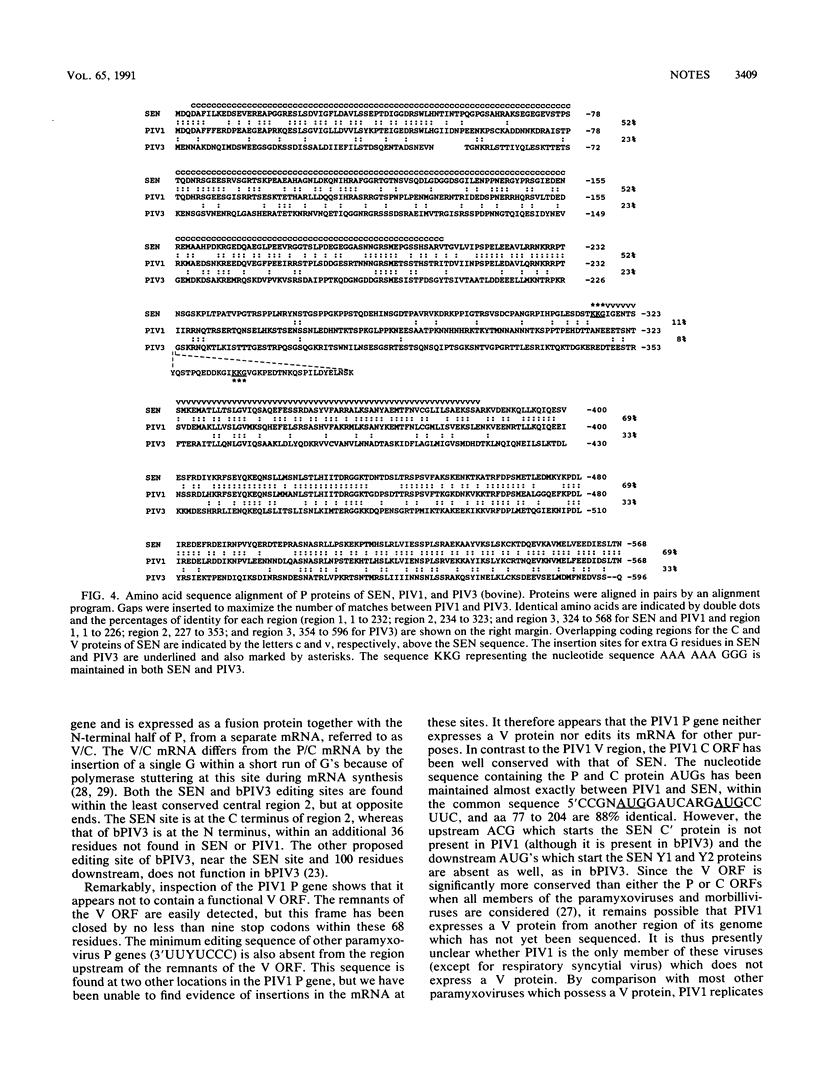
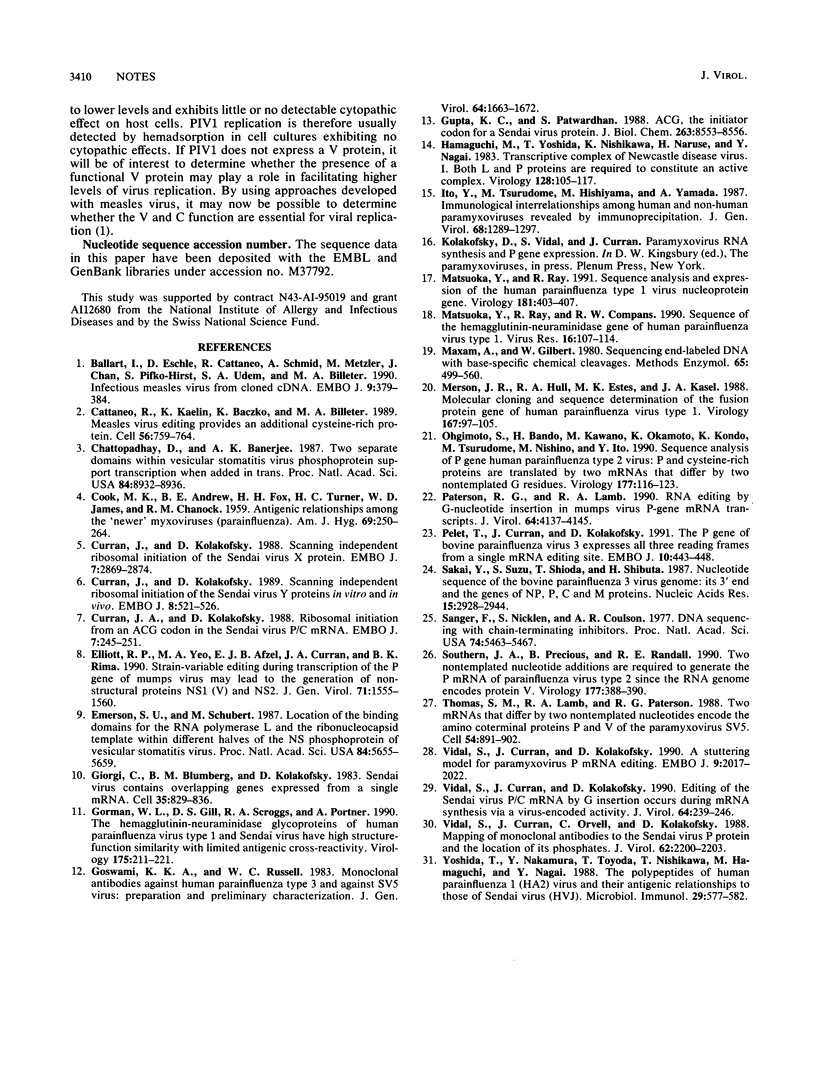
Images in this article
Selected References
These references are in PubMed. This may not be the complete list of references from this article.
- Ballart I., Eschle D., Cattaneo R., Schmid A., Metzler M., Chan J., Pifko-Hirst S., Udem S. A., Billeter M. A. Infectious measles virus from cloned cDNA. EMBO J. 1990 Feb;9(2):379–384. doi: 10.1002/j.1460-2075.1990.tb08121.x. [DOI] [PMC free article] [PubMed] [Google Scholar] [Retracted]
- COOK M. K., ANDREWS B. E., FOX H. H., TURNER H. C., JAMES W. D., CHANOCK R. M. Antigenic relationships among the newer myxoviruses (parainfluenza). Am J Hyg. 1959 May;69(3):250–264. doi: 10.1093/oxfordjournals.aje.a119998. [DOI] [PubMed] [Google Scholar]
- Cattaneo R., Kaelin K., Baczko K., Billeter M. A. Measles virus editing provides an additional cysteine-rich protein. Cell. 1989 Mar 10;56(5):759–764. doi: 10.1016/0092-8674(89)90679-x. [DOI] [PubMed] [Google Scholar]
- Chattopadhyay D., Banerjee A. K. Two separate domains within vesicular stomatitis virus phosphoprotein support transcription when added in trans. Proc Natl Acad Sci U S A. 1987 Dec;84(24):8932–8936. doi: 10.1073/pnas.84.24.8932. [DOI] [PMC free article] [PubMed] [Google Scholar]
- Curran J., Kolakofsky D. Ribosomal initiation from an ACG codon in the Sendai virus P/C mRNA. EMBO J. 1988 Jan;7(1):245–251. doi: 10.1002/j.1460-2075.1988.tb02806.x. [DOI] [PMC free article] [PubMed] [Google Scholar]
- Curran J., Kolakofsky D. Scanning independent ribosomal initiation of the Sendai virus X protein. EMBO J. 1988 Sep;7(9):2869–2874. doi: 10.1002/j.1460-2075.1988.tb03143.x. [DOI] [PMC free article] [PubMed] [Google Scholar]
- Curran J., Kolakofsky D. Scanning independent ribosomal initiation of the Sendai virus Y proteins in vitro and in vivo. EMBO J. 1989 Feb;8(2):521–526. doi: 10.1002/j.1460-2075.1989.tb03406.x. [DOI] [PMC free article] [PubMed] [Google Scholar]
- Elliott G. D., Yeo R. P., Afzal M. A., Simpson E. J., Curran J. A., Rima B. K. Strain-variable editing during transcription of the P gene of mumps virus may lead to the generation of non-structural proteins NS1 (V) and NS2. J Gen Virol. 1990 Jul;71(Pt 7):1555–1560. doi: 10.1099/0022-1317-71-7-1555. [DOI] [PubMed] [Google Scholar]
- Emerson S. U., Schubert M. Location of the binding domains for the RNA polymerase L and the ribonucleocapsid template within different halves of the NS phosphoprotein of vesicular stomatitis virus. Proc Natl Acad Sci U S A. 1987 Aug;84(16):5655–5659. doi: 10.1073/pnas.84.16.5655. [DOI] [PMC free article] [PubMed] [Google Scholar]
- Giorgi C., Blumberg B. M., Kolakofsky D. Sendai virus contains overlapping genes expressed from a single mRNA. Cell. 1983 Dec;35(3 Pt 2):829–836. doi: 10.1016/0092-8674(83)90115-0. [DOI] [PubMed] [Google Scholar]
- Gorman W. L., Gill D. S., Scroggs R. A., Portner A. The hemagglutinin-neuraminidase glycoproteins of human parainfluenza virus type 1 and Sendai virus have high structure-function similarity with limited antigenic cross-reactivity. Virology. 1990 Mar;175(1):211–221. doi: 10.1016/0042-6822(90)90201-2. [DOI] [PubMed] [Google Scholar]
- Goswami K. K., Russell W. C. Monoclonal antibodies against human paramyxovirus type 3 and against SV5 virus: preparation and preliminary characterization. J Gen Virol. 1983 Aug;64(Pt 8):1663–1672. doi: 10.1099/0022-1317-64-8-1663. [DOI] [PubMed] [Google Scholar]
- Gupta K. C., Patwardhan S. ACG, the initiator codon for a Sendai virus protein. J Biol Chem. 1988 Jun 25;263(18):8553–8556. [PubMed] [Google Scholar]
- Hamaguchi M., Yoshida T., Nishikawa K., Naruse H., Nagai Y. Transcriptive complex of Newcastle disease virus. I. Both L and P proteins are required to constitute an active complex. Virology. 1983 Jul 15;128(1):105–117. doi: 10.1016/0042-6822(83)90322-7. [DOI] [PubMed] [Google Scholar]
- Ito Y., Tsurudome M., Hishiyama M., Yamada A. Immunological interrelationships among human and non-human paramyxoviruses revealed by immunoprecipitation. J Gen Virol. 1987 May;68(Pt 5):1289–1297. doi: 10.1099/0022-1317-68-5-1289. [DOI] [PubMed] [Google Scholar]
- Matsuoka Y., Ray R., Compans R. W. Sequence of the hemagglutinin-neuraminidase gene of human parainfluenza virus type 1. Virus Res. 1990 Apr;16(1):107–113. doi: 10.1016/0168-1702(90)90047-f. [DOI] [PubMed] [Google Scholar]
- Matsuoka Y., Ray R. Sequence analysis and expression of the human parainfluenza type 1 virus nucleoprotein gene. Virology. 1991 Mar;181(1):403–407. doi: 10.1016/0042-6822(91)90514-c. [DOI] [PubMed] [Google Scholar]
- Maxam A. M., Gilbert W. Sequencing end-labeled DNA with base-specific chemical cleavages. Methods Enzymol. 1980;65(1):499–560. doi: 10.1016/s0076-6879(80)65059-9. [DOI] [PubMed] [Google Scholar]
- Merson J. R., Hull R. A., Estes M. K., Kasel J. A. Molecular cloning and sequence determination of the fusion protein gene of human parainfluenza virus type 1. Virology. 1988 Nov;167(1):97–105. doi: 10.1016/0042-6822(88)90058-x. [DOI] [PubMed] [Google Scholar]
- Ohgimoto S., Bando H., Kawano M., Okamoto K., Kondo K., Tsurudome M., Nishio M., Ito Y. Sequence analysis of P gene of human parainfluenza type 2 virus: P and cysteine-rich proteins are translated by two mRNAs that differ by two nontemplated G residues. Virology. 1990 Jul;177(1):116–123. doi: 10.1016/0042-6822(90)90465-4. [DOI] [PubMed] [Google Scholar]
- Paterson R. G., Lamb R. A. RNA editing by G-nucleotide insertion in mumps virus P-gene mRNA transcripts. J Virol. 1990 Sep;64(9):4137–4145. doi: 10.1128/jvi.64.9.4137-4145.1990. [DOI] [PMC free article] [PubMed] [Google Scholar]
- Pelet T., Curran J., Kolakofsky D. The P gene of bovine parainfluenza virus 3 expresses all three reading frames from a single mRNA editing site. EMBO J. 1991 Feb;10(2):443–448. doi: 10.1002/j.1460-2075.1991.tb07966.x. [DOI] [PMC free article] [PubMed] [Google Scholar]
- Sakai Y., Suzu S., Shioda T., Shibuta H. Nucleotide sequence of the bovine parainfluenza 3 virus genome: its 3' end and the genes of NP, P, C and M proteins. Nucleic Acids Res. 1987 Apr 10;15(7):2927–2944. doi: 10.1093/nar/15.7.2927. [DOI] [PMC free article] [PubMed] [Google Scholar]
- Sanger F., Nicklen S., Coulson A. R. DNA sequencing with chain-terminating inhibitors. Proc Natl Acad Sci U S A. 1977 Dec;74(12):5463–5467. doi: 10.1073/pnas.74.12.5463. [DOI] [PMC free article] [PubMed] [Google Scholar]
- Southern J. A., Precious B., Randall R. E. Two nontemplated nucleotide additions are required to generate the P mRNA of parainfluenza virus type 2 since the RNA genome encodes protein V. Virology. 1990 Jul;177(1):388–390. doi: 10.1016/0042-6822(90)90497-f. [DOI] [PubMed] [Google Scholar]
- Thomas S. M., Lamb R. A., Paterson R. G. Two mRNAs that differ by two nontemplated nucleotides encode the amino coterminal proteins P and V of the paramyxovirus SV5. Cell. 1988 Sep 9;54(6):891–902. doi: 10.1016/S0092-8674(88)91285-8. [DOI] [PMC free article] [PubMed] [Google Scholar]
- Vidal S., Curran J., Kolakofsky D. A stuttering model for paramyxovirus P mRNA editing. EMBO J. 1990 Jun;9(6):2017–2022. doi: 10.1002/j.1460-2075.1990.tb08330.x. [DOI] [PMC free article] [PubMed] [Google Scholar]
- Vidal S., Curran J., Kolakofsky D. Editing of the Sendai virus P/C mRNA by G insertion occurs during mRNA synthesis via a virus-encoded activity. J Virol. 1990 Jan;64(1):239–246. doi: 10.1128/jvi.64.1.239-246.1990. [DOI] [PMC free article] [PubMed] [Google Scholar]
- Vidal S., Curran J., Orvell C., Kolakofsky D. Mapping of monoclonal antibodies to the Sendai virus P protein and the location of its phosphates. J Virol. 1988 Jun;62(6):2200–2203. doi: 10.1128/jvi.62.6.2200-2203.1988. [DOI] [PMC free article] [PubMed] [Google Scholar]
- Yoshida T., Nakayama Y., Toyoda T., Nishikawa K., Hamaguchi M., Nagai Y. The polypeptides of human parainfluenza 1 (HA-2) virus and their antigenic relationships to those of Sendai virus (HVJ). Microbiol Immunol. 1985;29(6):577–582. doi: 10.1111/j.1348-0421.1985.tb00861.x. [DOI] [PubMed] [Google Scholar]



